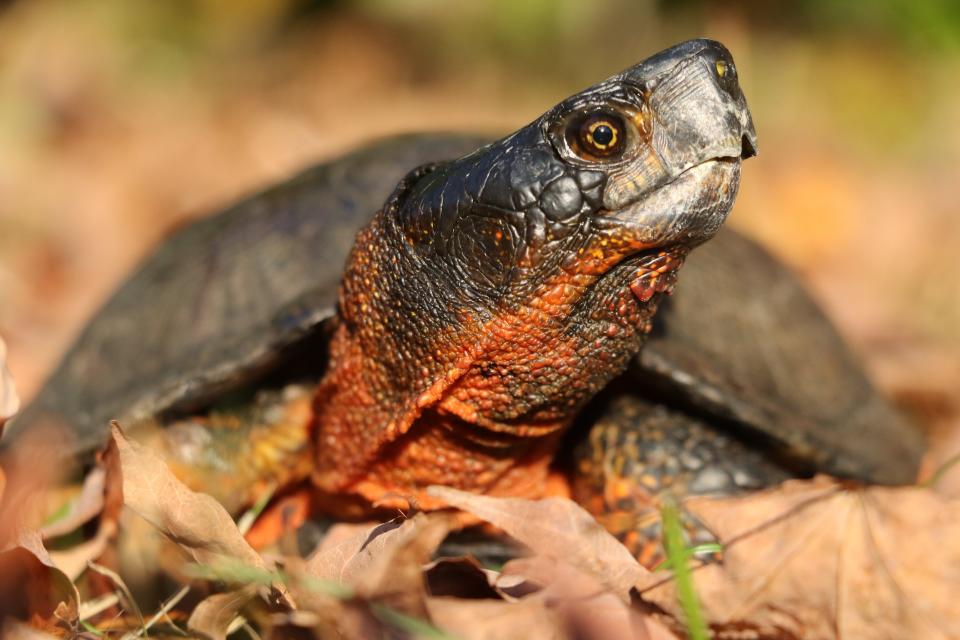MassWildlife book highlights state's efforts to save the wood turtle
Massachusetts is home to 10 native species of turtle, six of which are threatened or endangered.
A new book highlighting the biology and conservation of one in particular has been compiled, and the compendium of information on Glyptemys insculpta, the wood turtle, is the result of years of work from many wildlife agencies and conservation groups.
The endangered species has a patterned shell, distinctive orange coloring on its neck and legs, and wide, dark eyes.
“The wood turtle is a species that, I think, inspires real motivation in people to try to conserve it. It’s very charismatic. It has a very, sort of, intelligent appearance,” said Michael Jones, the MassWildlife state herpetologist and leading editor on the book, "Biology and Conservation of the Wood Turtle." “It’s unusual in Massachusetts to find another species quite like it.”

More than 10 years ago, Jones said, a working group of state agencies, biologists researchers, academics and land managers came together and have met yearly to pursue grants, develop population assessment protocols and team up for genetic studies, sharing knowledge and unpublished research to help conserve the species.
“It’s a real privilege to work with people who are so dedicated,” he said. “The state has a very active endangered species program that, for several decades has, I think, highlighted the conservation challenges of turtles.”
Not as common as they used to be
The wood turtle, which was once quite common, ranges from Maine to Virginia.
“They used to be found throughout Massachusetts except for Cape Cod and the Islands, so they were a species that you can find on the mainland, but they’ve had a really hard time inside (Interstate) 495,” Jones said. “We know from historical reports in the 1850s that wood turtles were extremely abundant in some of the towns in Worcester County — in areas where they’re almost impossible to find now.”
Jones said there have been many positive steps for conservation in the past few years, including better coordination between state agencies to curb illegal poaching and trade, and more work toward “stabilizing the small remaining turtle populations,” including habitat restoration.
“In some ways, it’s hard to talk about the best successes because oftentimes, they’re about a particular piece of land that was really good for wood turtles,” Jones said. “It undermines the value of that land to have it really well known where it is.”
It’s difficult to determine the specific cause of the wood turtle's decline because so much has happened since the 19th century — a “little ice age,” urbanization and urban sprawl fracturing habitats, and pollution in rivers and deforestation are all contributing factors.
“Our turtles don’t migrate to Florida," Jones said. "They live right here, year round, and they do it for decades. So if you have a turtle in any of these MetroWest towns, they’ll probably live their whole life there. Turtles need diverse landscapes. They need wetlands and vernal pools nearby, and streams and gravel pits.”
Jones stressed that turtles in general also need to be able to travel between those resources safely. He said the state Department of Transportation has been a leader in increasing safe connections for turtles through a program called Linking Landscapes and other efforts.
Helping turtles cross the road
If you see a turtle in the road, the best thing to do is help it in the direction that it’s going — if you can do that safely. A full guide on helping turtles across roads can be found online. Other species that MetroWest residents and visitors may see are the Blanding's turtle, Spotted Turtle and Eastern Box turtle.
“If you see a turtle on the roadway, put your own safety first,” Jones said. But “If you can help it in the direction it’s going, resist the temptation to bring it to a place you think is better.”
Turtles have a mental map of their environment — imagine being dropped in an unfamiliar town with no GPS and told to find your way back home.
“If you take it a mile or two away, it can get disoriented and die trying to get back,” Jones said. Most of the time, “they know best.”
Jones said concerned residents can get involved at the municipal level by alerting local conservation commissions or conservation agents to turtle crossings and roadkill; if you spot a turtle crossing the road, it can also be reported online to help “MassWildlife and MassDOT prioritize transportation projects to help turtles and other wildlife safely cross roads and keep driver safe,” according to their website.
“All of the turtles are quiet under the ice in little rivers right now. They’ll start coming out in early April, and then in May, they’ll be on roadways,” Jones said. “The more people in the MetroWest area who are aware of the problem, the better. Each town really requires a different solution to turtle roadkill and turtles dying on roadways — but that is one area people can help by just being more aware of the situation in their town.”
Lillian Eden can be reached at 617-459-6409 or leden@gannett.com. Follow her on Twitter @LillianWEden.
This article originally appeared on MetroWest Daily News: MassWildlife official's book highlights plight of wood turtle

